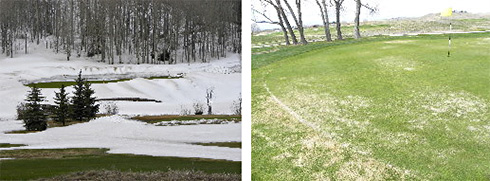
By Derf Soller, agronomist, Northwest Region
“O beautiful for spacious skies,
For amber waves of grain,
For purple mountain majesties
Above the fruited plain! “This first stanza of the song, America the Beautiful, came into my head on recent travels across our vast Northwest region. The skies were definitely spacious, but the mountains were more white than purple, and the plains seemed a little bit more windswept than fruited!
Although many golf course areas are in full growth, we seem to be lagging behind in the Central Rocky Mountain Region. Record snow in Colorado (500+ inches at Breckenridge Ski Area) and Utah mountains ( >800 inches at Snowbird) have kept upper elevation courses covered with lots of snow , and those that have melted off are certainly behind in their turf growth activity. The plains areas don’t have the lingering snow, but they have had mostly cool temperatures and spring winds that have kept soil temperature below optimum for good turf growth.
Areas of winter damage, whether from excessive snow and ice in the mountains, desiccation from a long winter, and lack of moisture and high winds, need proper temperatures to jump-start and encourage good turf recovery.
The delay of recovery has hindered the ability of some courses from starting annual spring cultural activities. This is actually ok, as actively growing turf will recover more rapidly than turf that is still dormant. But at recent TAS (Turf Advisory Service) visits, discussions with superintendents and course officials seem to be starting down the wrong path!
Some decisions being made don’t seem to be taking into account the long-term care of the courses. With calendar dates set, courses are reluctant to do what they know is needed: aeration of putting greens! They believe they can’t afford to do what’s best because of golfer backlash. Canceling proven cultural programs could be a disaster when the heat of the summer and the golf carts are running. Budgets, revenue expectations, and other issues are obviously essential components to the business of golf. But it’s helpful to keep the big picture in mind when having discussions about scheduling course care.
Private courses should just make room on the calendar and get it done. Public courses, while competing for the same golfing public, should get together and jointly communicate to their patrons the need for proper cultural maintenance programs. Maybe courses in an area could decide to conduct their green aeration on the same days! Then they all would have similar conditions for a week to ten days. This is an ongoing challenge we all face, and it’s not going away soon. Preparing courses in the spring after a long winter will help ensure terrific playing conditions in the summer ahead. And for you golfers out there, it would be great if you would support your favorite golf course and encourage them to aerate the greens to ultimately establish the best playing conditions possible!
In the Northwest Region of the USGA Green Section, contact either Larry Gilhuly, director, ([email protected]) or Derf Soller, agronomist ([email protected]) to answer any of your turf related questions, or to schedule a TAS visit to your golf course. Wendy Schwertfeger, administrative assistant, may also be reached for information at: 208.732.0280 or at [email protected].
